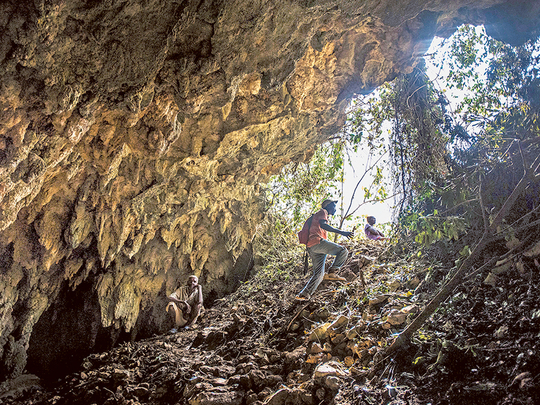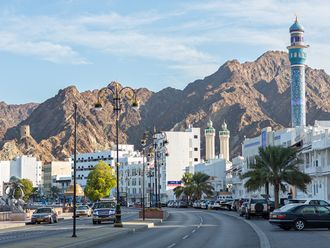
Lacadonie, Haiti: When the rain comes at night in these distant mountains, the people flee what homes they have left. They race down hills threaded with stones and ragged palm branches, the earth the colour of rust.
They arrive at a cave carved into the hillside, the only sanctuary left after the storm. It is a holy place now, having saved hundreds of villagers during the worst of Hurricane Matthew, when nature tore their homes to the ground. It is still the only thing to protect them.
For four days and nights, they huddled in its womb before emerging, frightened the hurricane might return. They slept on a floor of stacked boulders near the cave’s mouth, lighting small fires for warmth and light.
When they left, they salvaged enough to shield them from the sun, a few corroded sheets of zinc and scattered wooden beams. But when it rains they return to the cave, their shacks unable to keep the water out. And despite the odour and humidity, the unforgiving crags and profound darkness, they are thankful.
“It is our house that God created when we most needed it,” said Destine Jean, one of the villagers who first alerted the government of the closest town, Beaumont, to the people living in caves. “Without this cave, a lot of people would have died. This is the only shelter we have.”
For much of the world, Haiti is known more as a crisis than a country. Disaster, whether man-made or natural, has come to define the nation, where progress is often just a prelude to another step back. Dictators, corrupt officials and international meddling have competed with earthquakes and hurricanes to destabilise the country.
There is a mean echo to the hurricane’s fallout this time around. After the 2010 earthquake flattened the capital and its surroundings, the struggle to get hundreds of thousands of Haitians out of tent cities and back into homes defined the nation’s recovery.
Now, schools and hospitals are again overflowing with the displaced, people whose homes are so gutted that leaving them makes more sense than staying. Where there is no shelter, residents are stripped to bare survival and forced to find their own way, even in caves.
Deplorable circumstances
Officials in Beaumont say there are at least six caves they know of like this one, sheltering a total of 550 people living amid the moss-coloured alps of the country’s southwest. It was not until leaders like Jean gradually made their way down to seek help that officials even realised the people were living in caves.
The mayor of Beaumont, Alexis Faveur, shook his head in disbelief as he described the damage left by the hurricane this month, and the deplorable circumstances it reduced them to.
He dispatches workers every few days to check on the villages, sending them on a climb of several hours, bearing bags of rice, beans, pasta and cooking oil. But there was no space for any more survivors in Beaumont; the shelters are already overcrowded.
“The only place they can seek shelter is the cave,” he said, seated at a desk in his office, with blown-out windows and no electricity. “There are no more houses there.”
The village of Lacadonie embodies the very worst of what this hurricane has left behind.
Families scour for crops spared by the rain and scavenge the hillsides for plantains and beans not yet turned. A woman cooks rancid goat meat for her children, rinsing the blackened flesh with sour orange to cut the smell. Families mourn their dead in night-time rituals, the spirits excised without being counted in a formal registry.
Risked her life
Residents have started the hard work of rebuilding, fitting together the broken pieces of their homes and lives without a trace of self-pity. Most estimate it will be years before they can afford to restore their residences, even to the humble state they were in before. For now, they will make do with far more modest accommodations.
The first home to be rebuilt after the storm belonged to L’Anise Nazaire, who owns the lands where the cave is.
A slight 55-year-old whose shyness belies her courage, Nazaire risked her life to implore people to flee, delegating the task of saving her own mother to neighbours so that she could race up the mountain and warn others. She led them to the cave and the soaring cathedral of stalagmites at its base, where thick bands of light issue from an opening above. Many risked the steep descent to feel the sunlight during their stay.
“After God, she gave us life,” Celor Montuna, a skeletal 54-year-old farmer, said of Nazaire. “She came and saved us.”
During the storm, they watched through the mouth of the cave as the wind and rain sowed destruction, carrying entire trees past the entrance like leaves tossed on a breeze.
“I thought Jesus was coming,” said Nazaire, pausing for a moment before breaking into a fit of laughter.
For all the gratitude, she claims no glory. The second phase of survival leaves no time for victory laps. In her newly constructed home, a jigsaw puzzle of retrofitted planks, thatched tinder and rescued roofing, everyone is busy.
“My life would be worthless without the others,” she said. “Without them, I would be dead myself.”












